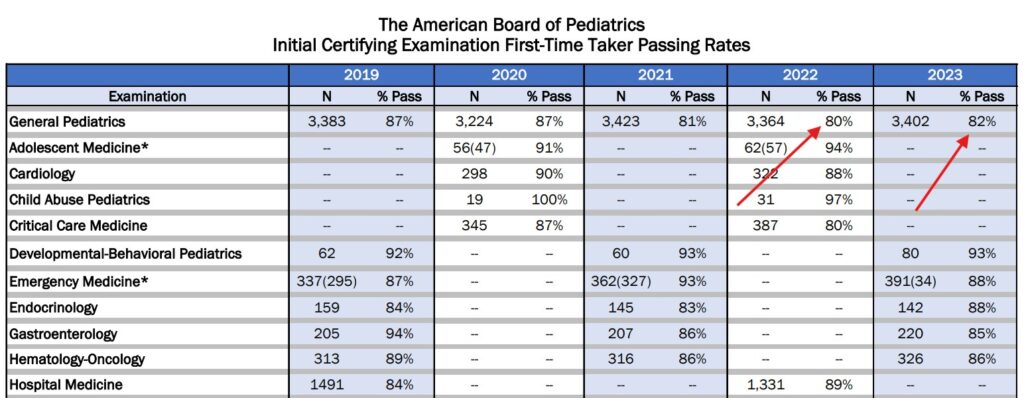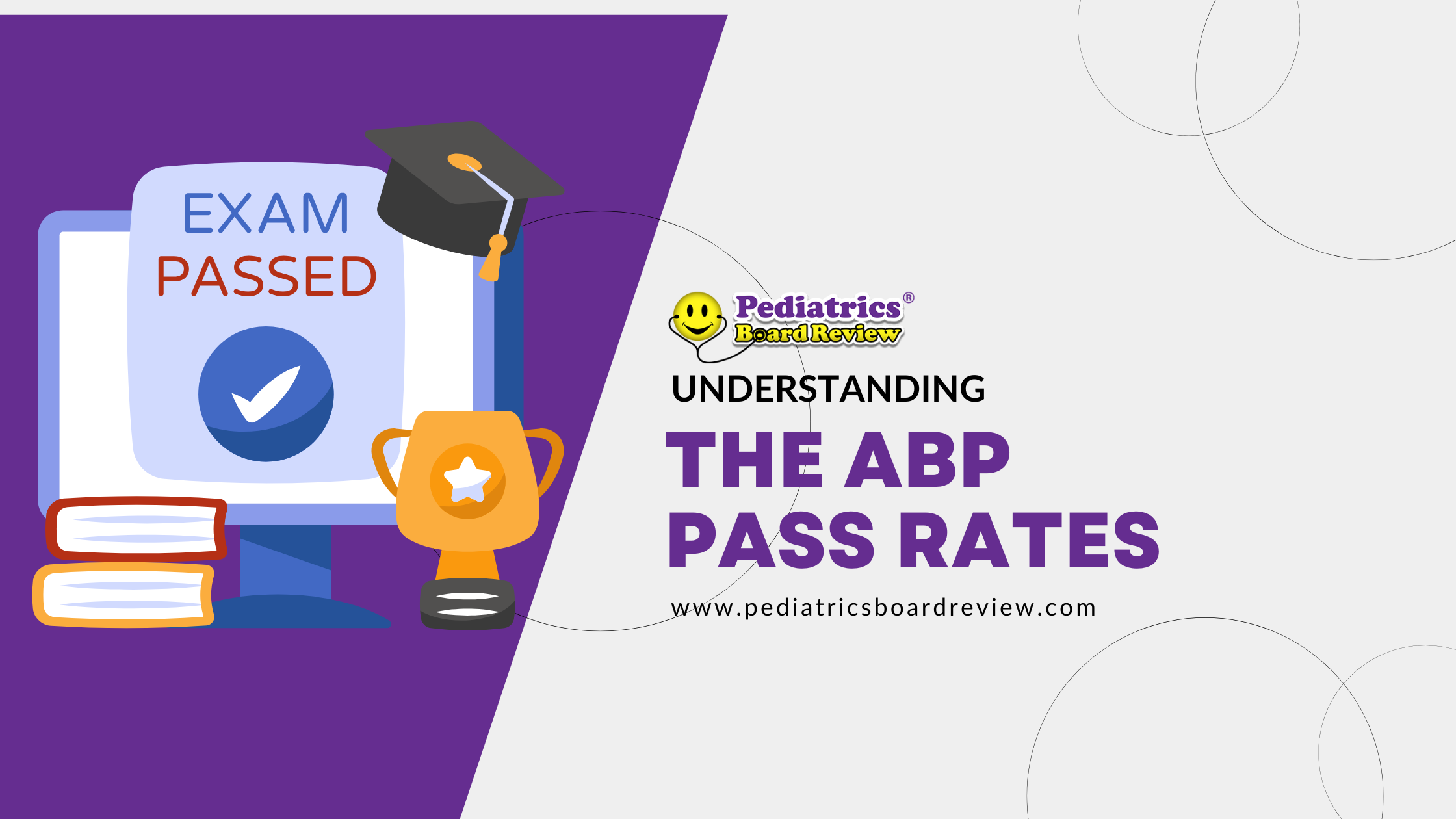American Board of Pediatrics Pass Rates Revealed!
My Journey to Understanding American Board of Pediatrics (ABP) Pass Rates
When I took the American Board of Pediatrics (ABP) certification exam for the first time, it was a challenging. It was only later that I realized that the first-time pass rate for the American Board of Pediatrics (ABP) initial certification exam was only about 80%. I was shocked to find out that approximately 20% of first-time test-takers fail.
But, then something changed at the American Board of Pediatrics. With that change came a prediction that turned out to be true. That’s when I wrote my article titled, “Could the Pediatric Boards Pass Rate be 100% this Year?”. I discussed the possibility of having a dramatically improved overall pass rate for first-time test takers.
The Two Key Reasons Why ABP Pass Rates Increased
In the past, the American Board of Pediatrics (ABP) essentially graded pediatricians on a “curve.” A pass rate would be set to an arbitrary number, such as 75%. Then, even 100% percent of pediatricians did quite well on the exam, the bottom 25% of first-time test-takers would fail.
In 2012, the American Board of Pediatrics changed how they score pediatricians on the boards. Simply put, in order to pass, pediatricians had to answer a certain percentage of questions correct. Meaning, if 100% of pediatricians answered enough questions correctly, then 100% of the pediatricians would pass!
I was ecstatic to hear about this change and felt it was much more fair. To learn even more about the scoring system instituted in 2012, read the PBR article titled, “ABP Exam Scoring Changes.”
The additional change was a change from a paper exam to a computer-based exam. Initially, there was a great deal of uncertainty as to how pediatricians would perform with the new style of testing.
The Shocking Results
For the six years prior to scoring changes, the pediatric board exam pass rates had all been between 76% – 79%. In the year of the scoring changes, the pass rate increased by 10%.

I was shocked. I predicted a higher pass rate, but ten percent? So, what happened?
First, the American Board of Pediatrics received a directive from an oversight organization forcing them to make some changes. The pediatric initial certification exam has one of the lowest pass rates in the medical field, and an improved pass rate was one of the changes that needed to be made.
Second, there was NO limit to the number of times a pediatrician could take, and fail, the pediatric boards. Along with the scoring changes, a 7-year limit was placed on board eligibility. With this rule in place, a pediatrician MUST pass the pediatric boards within 7 years of graduating from their residency program.
If you do not pass the boards within this 7-year limit, you must go through a period of retraining, which can cost tens of thousands of dollars.
The Evolution of Pediatric Board Exam Pass Rates
After the changes were instituted, I was pleasantly surprised to see the pass rates slowly increase over the year. In 20??, the first-time pass rate was even as high as 91%.
Unfortunately, that trend did not last. Over the years, the pass rates have fluctuated and even come back down to approximately 80% as seen in the image below. Why? Only the American Board of Pediatrics knows.

What Does This Mean for Test-Takers
Throughout all of the changes in scoring and pass rates, pediatricians have never said to me, “That exam was easy!” The reason is because the initial certification exam is hard. It was the first board exam that I ever failed.
After making many strategic changes to my board preparation, including a focus on test-taking strategy, I was able to score above the national average the following year. I was even asked by the American Board of Pediatrics to write questions for them. But, even I wasn’t confident coming out of my second attempt at the boards.
Key Takeaways
 For you, there are a few key takeaways from all of this.
For you, there are a few key takeaways from all of this.
First, ignore the pass rates. You should ASSUME that the exam that you take will be challenging. I wasn’t afraid of the boards the first time I took them because I had never failed a board exam in my life. But, having a bit of fear can be healthy, and it can reshape your board preparation experience for the better.
Second, keep in mind that there is a “hard way” to prepare for the boards, and there is the “PBR Way.” I failed, but then I went on to pass with a score above the national average. I’ve been able to go on to help pediatricians pass after 1, 3, 5, 7, and even 10 failed attempts.
The reason isn’t because I’m brilliant. It’s because:
- I know what content is testable.
- I know what content I should keep OUT of the PBR resources to “avoid information overwhelm.”
- I’ve worked with thousands of pediatricians.
- I focus on keeping this simple, concise, and strategic.
The American Board of Pediatrics first-time pass rate has been higher than 90% and lower than 80%. But since Pediatrics Board Review (PBR) was started in 2011, there has ALWAYS been a 100% Money Back First-Time Pass Guarantee. Yet, less than 0.5% of PBR members have ever requested a guarantee disbursement.
We know what we’re doing. If we’ve been able to help pediatricians pass on their tenth and eleventh attempts, we can help you too.
Don’t prepare the “hard way.” Click here now and learn to easily pass the “PBR Way.”
Download Two Free Chapters From the PBR & See If It's Right For You!
FREE Pediatric Dermatology Study Guide
FREE Pediatric GI Study Guide
We promise not to use your email for spam!

Ashish Goyal, MD
CEO, Pediatrics Board Review Inc.
Board Certified Pediatrician
Board Certified Internist
American Board of Pediatrics (ABP) Question Contributor
Author, Pediatrics Board Review Educational Series
Founder of AVSAR, a 501-c-3 nonprofit organization
Web: www.PediatricsBoardReview.com




